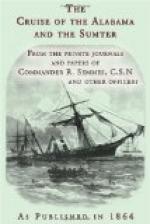Captain Semmes at once replied that he would attend upon the committee immediately. His next act was respectfully to resign his commission as Commander in the Navy of the United States; which resignation was accepted in the same terms. He ceased similarly to be a member of the Lighthouse Board. These matters concluded, he telegraphed to the Hon. J.L.M. Curry, in Montgomery, where the Confederate States’ Congress was sitting, that he was now a free man to serve his struggling country. Forthwith he was deputed by President Davis to return to the Northern States, and make large purchases and contracts “for machinery and munitions, or for the manufacture of arms and munitions of war;” as also to obtain “cannon and musket-powder, the former of the coarsest grain,” and to engage with a certain proprietor of powder-mills for the “establishment of a powder-mill at some point in the limits of our territory.” This letter gives a good idea of the business-like qualities brought by Mr. Davis to his high office. “At the arsenal at Washington,” he writes, “you will find an artificer named Wright, who has brought the cap-making machine to its present state of efficiency, and who might furnish a cap-machine, and accompany it, to explain its operations.” Throughout the letter, which is full of minute instructions and weighty commissions, Mr. Davis shows the fullest confidence in the loyalty and fitness of the man in whom he placed trust.
Captain Semmes was engaged in the performance of these immediate duties, when a confidential communication from Mr. S.R. Mallory, of the Navy department, gave him warning of two or more steamers, of a class desired for present service, which might be purchased at or near New York—“steamers of speed, light draught, and strength sufficient for at least one heavy gun.”
“The steamers are designed to navigate the waters and enter the bays and inlets of the coast from Charleston to the St. Mary’s, and from Key West to the Rio Grande, for coast defences;” and Captain Semmes’ judgment will need no further guide when he is told that “their speed should be sufficient to give them at all times the ability to engage or to evade an engagement, and that an 8 or 10-inch gun, with, perhaps, two 32, or, if not, two of smaller calibre, should constitute their battery.”
The Captain’s appointment as Commander in the Navy of the Confederate States, and taking of the oaths, followed in April. On the 18th of that month, Mr. Mallory detached him from the post he held, by appointment from the President, of Chief of the Lighthouse Bureau, with orders that he should proceed to New Orleans and take command of the steamer Sumter. Captain Semmes saw clearly that war was coming. He perceived, at the same time, the means by which he could serve his country best. He set forth for New Orleans without delay.




